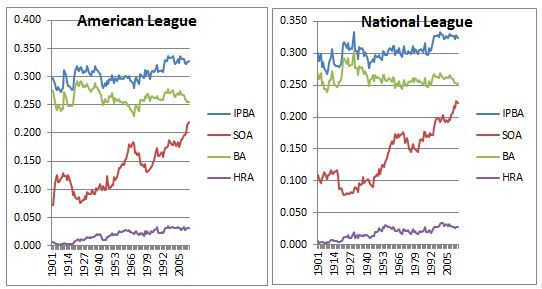This posting will use four baseball statistics, batting average (AVG), in-play batting average (IPBA), strike-out average (SOA) and home-run average (HRA). Their definitions are AVG = #H/#AB, IPBA = #H/(#AB−#SO), SOA =#SO/#AB and HRA = #HR/#AB. It turns out that AVG = IPBA*(1−SOA). The two figures below show these four statistics for the years 1901 thru 2013 for both leagues.

My first observation about these two graphs is how similar these four statistics are between the two leagues. Concentrating on the statistic SOA from 1901 to 2013, we can make these observations. From 1910 to about 1950 the SOA hovered around .100. From the early 50s to the late 60s we see our first spike in SOA to around .170. A reduction in the height of the mound in 1968 along with a tighter strike-zone caused a drop in SOA to about .150 in the 70s. From the 80s until today the SOA has spiked sharply upward to over .210. This year the SOA could exceed .220 and be the highest for any year in the history of baseball. Because of the formula which associates AVG with both SOA and IPBA one can see as the SOA increases the gap widens between the AVG and the IPBA. Specifically looking at the two periods of time 1920-1930 and 2003-2013 (about 80 games) for the AL, we have a mean SOA of .084 for 1920 to 1930 compared to a mean SOA of .193 for 2003 to 2013.
Chapter 17 of Sandlot Stats is titled Mission Impossible: Batting .400 for a Season and the entire chapter presents what is necessary for a player today to hit .400 for a season. Since 1913, there have been nine Major League players to achieve an AVG of at least .400 for a season. Of those nine, eight occurred between the years 1920 and 1930. The only other player to achieve this feat was Ted Williams when he batted .406 in 1941. Using regression analysis, I show in this chapter that the ideal numbers for a player to hit .400 are an SOA < .066 and an IPBA > .427. The nine players who batted .400 had a mean SOA of .065 and a mean IPBA of .428. To illustrate what a .066 SOA means let us assume a player has 600 at-bats. For his SOA to be less than .066 he would have to strike-out less than 40 times (never happens today).
Is it plausible for a player today to have a .427 IPBA and a .066 SOA? Well, in 2012, the highest IPBA was Trout’s .433 (SOA = .249) and the lowest SOA was Scutaro’s .079 (IPBA = .333). Posey’s pair was .410 and .181 and Miguel Cabrera’s pair was .391 and .158. In 2013, Cabrera’s pair after 82 games is IPBA =.451 and SOA = .183 with a batting average of .368. As great of a hitter as Cabrera is, his SOA will clearly stop him from hitting .400. In my opinion, the SOA will stop any of today’s players from reaching the special number of a .400 batting average.
